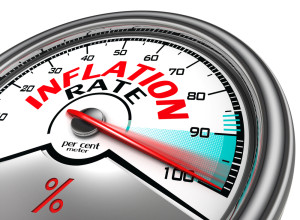 In today’s day and age, it seems like everyone expects a future filled with price inflation. And who can blame people? Over the past 50 years, prices have increased seven-fold. That’s not a typo. According to the Bureau of Labor Statistics’ “CPI Inflation Calculator,” on average, what you could buy for $1 in 1964 will now cost $7.69. If you are a young person getting ready to enter the workforce, let that figure sink in.
In today’s day and age, it seems like everyone expects a future filled with price inflation. And who can blame people? Over the past 50 years, prices have increased seven-fold. That’s not a typo. According to the Bureau of Labor Statistics’ “CPI Inflation Calculator,” on average, what you could buy for $1 in 1964 will now cost $7.69. If you are a young person getting ready to enter the workforce, let that figure sink in.
At some point in our nation’s past, it became conventional wisdom that prices would rise year in and year out. It’s almost as if price hikes joined taxes and death as the only certainties in life. Policy makers sell to the citizenry the idea that price inflation is a necessity for strong economic growth—and simultaneously denounce price deflation or lower amounts of price inflation as barriers to economic progress. But history doesn’t necessarily agree.
The Federal Reserve Bank of Minneapolis kindly provides consumer price data dating back to 1800. Not surprisingly, prices are a lot higher today than they were back then. With that said, it’s interesting to note that what you could buy for $1 in 1800, you could buy for $1 in 1816. In fact, after 1816, prices fell, meaning people’s purchasing power actually increased. Perhaps incredibly to some inflationists, purchasing power didn’t fall below the level it was in 1800 until 1919, more than 100 years later. In 1930, purchasing power would again increase above the level from 1800 and remain higher until 1943, when the value of $1 would never again be worth what it once was.
This begs the question: Was there no economic progress made from 1800 to 1816? How about from 1800 to 1919? Or, incredibly, would inflation apologists really claim that the United States didn’t advance economically or technologically for over 140 years, from 1800 to 1943? Were businesses unable to hire more people, bring new products to the market, and/or make a profit from 1800 to 1943? After all, the value of $1 in 1800, while it did fluctuate quite a bit in the interim, still had the same purchasing power in 1943. If there is anyone who believes economic progress in the United States did not advance from 1800 to 1943, I suggest brushing up on history.
I manage my investment portfolio with the expectation of future price increases. I do so not because I think deflation is a horrid evil that must be banished from the earth but rather because very powerful, entrenched interests stand in the way of and actively attempt to fight stable or falling prices. Additionally, I recognize that consumer price hikes, credit growth, and price rises in financial assets have become structurally important to today’s economic system. A shift from today’s reality to a different economic model would cause too much short-term pain for too many individuals. Hence, the ever-rising-prices party continues on. But just because getting to a world of long-term stable prices would cause tremendous short-term pain doesn’t mean a world of long-term stable prices would be a dreadful one from an economic perspective. The next time someone tells you otherwise, ask that person how much economic progress was made in the United States between 1800 and 1943.
More from The Financial Lexicon:
The 5 Fundamentals of Building a Retirement Portfolio
Options Strategies Every Investor Should Know
Trusted & Regulated Stock & CFD Brokers
What we like
- 0% Fees on Stocks
- 5000+ Stocks, ETFs and other Markets
- Accepts Paypal Deposits
Min Deposit
$200
Charge per Trade
Zero Commission on real stocks
64 traders signed up today
Visit Now67% of retail investor accounts lose money when trading CFDs with this provider. You should consider whether you can afford to take the high risk of losing your money.
Available Assets
- Total Number of Stocks & Shares5000+
- US Stocks
- German Stocks
- UK Stocks
- European
- ETF Stocks
- IPO
- Funds
- Bonds
- Options
- Futures
- CFDs
- Crypto
Charge per Trade
- FTSE 100 Zero Commission
- NASDAQ Zero Commission
- DAX Zero Commission
- Facebook Zero Commission
- Alphabet Zero Commission
- Tesla Zero Commission
- Apple Zero Commission
- Microsoft Zero Commission
Deposit Method
- Wire Transfer
- Credit Cards
- Bank Account
- Paypall
- Skrill
- Neteller
What we like
- Sign up today and get $5 free
- Fractals Available
- Paypal Available
Min Deposit
$0
Charge per Trade
$1 to $9 PCM
Visit Now
Investing in financial markets carries risk, you have the potential to lose your total investment.
Available Assets
- Total Number of Shares999
- US Stocks
- German Stocks
- UK Stocks
- European Stocks
- EFTs
- IPOs
- Funds
- Bonds
- Options
- Futures
- CFDs
- Crypto
Charge per Trade
- FTSE 100 $1 - $9 per month
- NASDAQ $1 - $9 per month
- DAX $1 - $9 per month
- Facebook $1 - $9 per month
- Alphabet $1 - $9 per month
- Telsa $1 - $9 per month
- Apple $1 - $9 per month
- Microsoft $1 - $9 per month
Deposit Method
- Wire Transfer
- Credit Cards
- Bank Account



